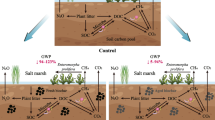Abstract
Particle-size fractionation of a heavy metal polluted soil was performed to study the influence of environmental pollution on microbial community structure, microbial biomass, microbial residues and enzyme activities in microhabitats of a Calcaric Phaeocem. In 1987, the soil was experimentally contaminated with four heavy metal loads: (1) uncontaminated controls; (2) light (300 ppm Zn, 100 ppm Cu, 50 ppm Ni, 50 ppm V and 3 ppm Cd); (3) medium; and (4) heavy pollution (two- and threefold the light load, respectively). After 10 years of exposure, the highest concentrations of microbial ninhydrin-reactive nitrogen were found in the clay (2–0.1 μm) and silt fractions (63–2 μm), and the lowest were found in the coarse sand fraction (2,000–250 μm). The phospholipid fatty acid analyses (PLFA) and denaturing gradient gel electrophoresis (DGGE) separation of 16S rRNA gene fragments revealed that the microbial biomass within the clay fraction was predominantly due to soil bacteria. In contrast, a high percentage of fungal-derived PLFA 18 : 2ω6 was found in the coarse sand fraction. Bacterial residues such as muramic acid accumulated in the finer fractions in relation to fungal residues. The fractions also differed with respect to substrate utilization: Urease was located mainly in the <2 μm fraction, alkaline phosphatase and arylsulfatase in the 2–63 μm fraction, and xylanase activity was equally distributed in all fractions. Heavy metal pollution significantly decreased the concentration of ninhydrin-reactive nitrogen of soil microorganisms in the silt and clay fraction and thus in the bulk soil. Soil enzyme activity was reduced significantly in all fractions subjected to heavy metal pollution in the order arylsulfatase >phosphatase >urease >xylanase. Heavy metal pollution did not markedly change the similarity pattern of the DGGE profiles and amino sugar concentrations. Therefore, microbial biomass and enzyme activities seem to be more sensitive than 16S rRNA gene fragments and microbial amino-sugar-N to heavy metal treatment.
Similar content being viewed by others
Author information
Authors and Affiliations
Additional information
Received: 21 January 2000
Rights and permissions
About this article
Cite this article
Kandeler, E., Tscherko, D., Bruce, K. et al. Structure and function of the soil microbial community in microhabitats of a heavy metal polluted soil. Biol Fertil Soils 32, 390–400 (2000). https://doi.org/10.1007/s003740000268
Issue Date:
DOI: https://doi.org/10.1007/s003740000268




